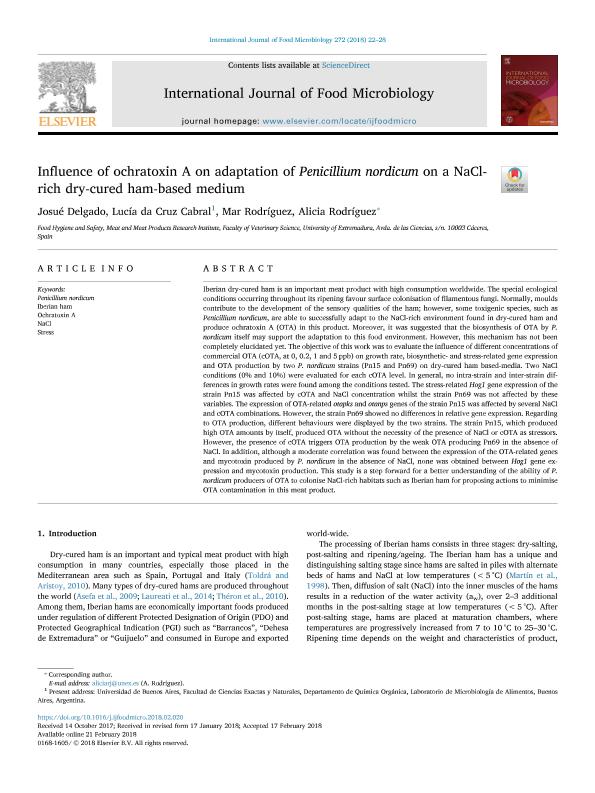Mostrar el registro sencillo del ítem
dc.contributor.author
Delgado, Josué
dc.contributor.author
Da Cruz Cabral, Lucía Mariana

dc.contributor.author
Rodríguez, Mar
dc.contributor.author
Rodríguez, Alicia
dc.date.available
2020-02-03T20:17:02Z
dc.date.issued
2018-05
dc.identifier.citation
Delgado, Josué; Da Cruz Cabral, Lucía Mariana; Rodríguez, Mar; Rodríguez, Alicia; Influence of ochratoxin A on adaptation of Penicillium nordicum on a NaCl-rich dry-cured ham-based medium; Elsevier Science; International Journal of Food Microbiology; 272; 5-2018; 22-28
dc.identifier.issn
0168-1605
dc.identifier.uri
http://hdl.handle.net/11336/96590
dc.description.abstract
Iberian dry-cured ham is an important meat product with high consumption worldwide. The special ecological conditions occurring throughout its ripening favour surface colonisation of filamentous fungi. Normally, moulds contribute to the development of the sensory qualities of the ham; however, some toxigenic species, such as Penicillium nordicum, are able to successfully adapt to the NaCl-rich environment found in dry-cured ham and produce ochratoxin A (OTA) in this product. Moreover, it was suggested that the biosynthesis of OTA by P. nordicum itself may support the adaptation to this food environment. However, this mechanism has not been completely elucidated yet. The objective of this work was to evaluate the influence of different concentrations of commercial OTA (cOTA, at 0, 0.2, 1 and 5 ppb) on growth rate, biosynthetic- and stress-related gene expression and OTA production by two P. nordicum strains (Pn15 and Pn69) on dry-cured ham based-media. Two NaCl conditions (0% and 10%) were evaluated for each cOTA level. In general, no intra-strain and inter-strain differences in growth rates were found among the conditions tested. The stress-related Hog1 gene expression of the strain Pn15 was affected by cOTA and NaCl concentration whilst the strain Pn69 was not affected by these variables. The expression of OTA-related otapks and otanps genes of the strain Pn15 was affected by several NaCl and cOTA combinations. However, the strain Pn69 showed no differences in relative gene expression. Regarding to OTA production, different behaviours were displayed by the two strains. The strain Pn15, which produced high OTA amounts by itself, produced OTA without the necessity of the presence of NaCl or cOTA as stressors. However, the presence of cOTA triggers OTA production by the weak OTA producing Pn69 in the absence of NaCl. In addition, although a moderate correlation was found between the expression of the OTA-related genes and mycotoxin produced by P. nordicum in the absence of NaCl, none was obtained between Hog1 gene expression and mycotoxin production. This study is a step forward for a better understanding of the ability of P. nordicum producers of OTA to colonise NaCl-rich habitats such as Iberian ham for proposing actions to minimise OTA contamination in this meat product.
dc.format
application/pdf
dc.language.iso
eng
dc.publisher
Elsevier Science

dc.rights
info:eu-repo/semantics/openAccess
dc.rights.uri
https://creativecommons.org/licenses/by-nc-sa/2.5/ar/
dc.subject
IBERIAN HAM
dc.subject
NACL
dc.subject
OCHRATOXIN A
dc.subject
PENICILLIUM NORDICUM
dc.subject
STRESS
dc.subject.classification
Alimentos y Bebidas

dc.subject.classification
Otras Ingenierías y Tecnologías

dc.subject.classification
INGENIERÍAS Y TECNOLOGÍAS

dc.title
Influence of ochratoxin A on adaptation of Penicillium nordicum on a NaCl-rich dry-cured ham-based medium
dc.type
info:eu-repo/semantics/article
dc.type
info:ar-repo/semantics/artículo
dc.type
info:eu-repo/semantics/publishedVersion
dc.date.updated
2019-10-09T20:45:48Z
dc.journal.volume
272
dc.journal.pagination
22-28
dc.journal.pais
Países Bajos

dc.journal.ciudad
Amsterdam
dc.description.fil
Fil: Delgado, Josué. Universidad de Extremadura; España
dc.description.fil
Fil: Da Cruz Cabral, Lucía Mariana. Universidad de Extremadura; España. Consejo Nacional de Investigaciones Científicas y Técnicas. Oficina de Coordinación Administrativa Ciudad Universitaria. Instituto de Ecología, Genética y Evolución de Buenos Aires. Universidad de Buenos Aires. Facultad de Ciencias Exactas y Naturales. Instituto de Ecología, Genética y Evolución de Buenos Aires; Argentina
dc.description.fil
Fil: Rodríguez, Mar. Universidad de Extremadura; España
dc.description.fil
Fil: Rodríguez, Alicia. Universidad de Extremadura; España
dc.journal.title
International Journal of Food Microbiology

dc.relation.alternativeid
info:eu-repo/semantics/altIdentifier/url/https://www.sciencedirect.com/science/article/pii/S0168160518300710
dc.relation.alternativeid
info:eu-repo/semantics/altIdentifier/doi/http://dx.doi.org/10.1016/j.ijfoodmicro.2018.02.020
Archivos asociados
